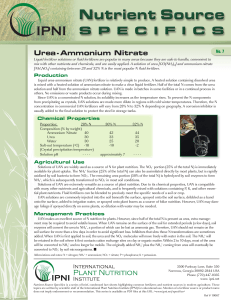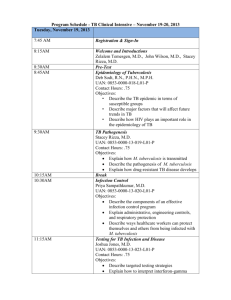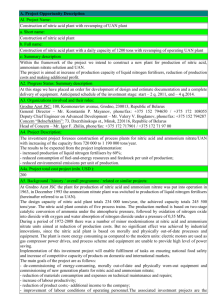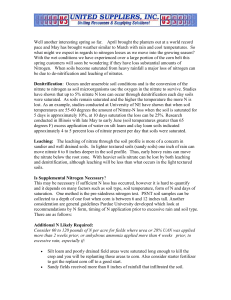Urea Ammonium Nitrate Solution
advertisement
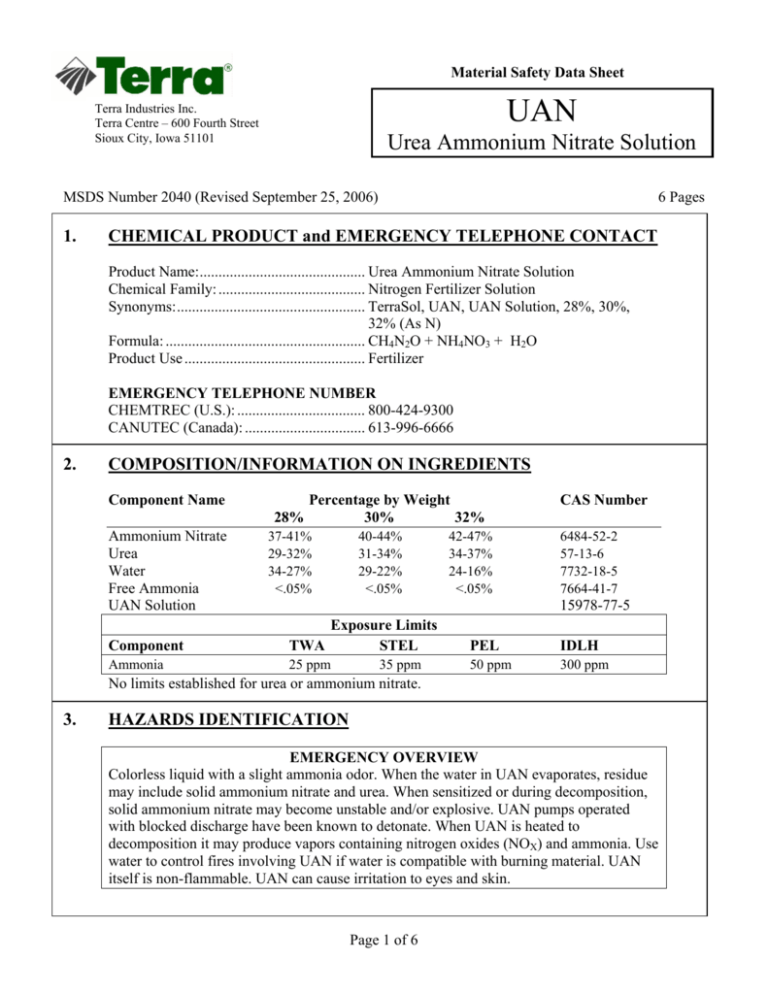
Material Safety Data Sheet UAN Terra Industries Inc. Terra Centre – 600 Fourth Street Sioux City, Iowa 51101 Urea Ammonium Nitrate Solution MSDS Number 2040 (Revised September 25, 2006) 1. 6 Pages CHEMICAL PRODUCT and EMERGENCY TELEPHONE CONTACT Product Name:............................................ Urea Ammonium Nitrate Solution Chemical Family: ....................................... Nitrogen Fertilizer Solution Synonyms:.................................................. TerraSol, UAN, UAN Solution, 28%, 30%, 32% (As N) Formula: ..................................................... CH4N2O + NH4NO3 + H2O Product Use ................................................ Fertilizer EMERGENCY TELEPHONE NUMBER CHEMTREC (U.S.): .................................. 800-424-9300 CANUTEC (Canada): ................................ 613-996-6666 2. COMPOSITION/INFORMATION ON INGREDIENTS Component Name Ammonium Nitrate Urea Water Free Ammonia UAN Solution Percentage by Weight 28% 30% 32% 37-41% 29-32% 34-27% <.05% 40-44% 31-34% 29-22% <.05% 42-47% 34-37% 24-16% <.05% CAS Number 6484-52-2 57-13-6 7732-18-5 7664-41-7 15978-77-5 Component Exposure Limits TWA STEL PEL IDLH Ammonia 25 ppm 50 ppm 300 ppm 35 ppm No limits established for urea or ammonium nitrate. 3. HAZARDS IDENTIFICATION EMERGENCY OVERVIEW Colorless liquid with a slight ammonia odor. When the water in UAN evaporates, residue may include solid ammonium nitrate and urea. When sensitized or during decomposition, solid ammonium nitrate may become unstable and/or explosive. UAN pumps operated with blocked discharge have been known to detonate. When UAN is heated to decomposition it may produce vapors containing nitrogen oxides (NOX) and ammonia. Use water to control fires involving UAN if water is compatible with burning material. UAN itself is non-flammable. UAN can cause irritation to eyes and skin. Page 1 of 6 POTENTIAL HEALTH EFFECTS Primary Routes of Entry: Skin contact/absorption and eye contact. General Acute Exposure: Contact with skin or eyes may cause irritation. UAN is not acutely toxic by the oral route of exposure. General Chronic Exposure: No test data available. Carcinogenicity: NTP: ........................................................... Not Listed IARC: ......................................................... Not Listed OSHA:........................................................ Not Regulated Medical Conditions Aggravated by Exposure: No test data available. 4. FIRST AID MEASURES First Aid for Eyes: Immediately flush eyes with copious amounts of tepid water for at least 15 minutes. If irritation, pain, swelling, excessive tearing, or light sensitivity persists, the patient should be seen in a health care facility. First Aid for Skin: Immediately flush exposed area with copious amounts of tepid water for at least 15 minutes followed by washing area thoroughly with soap and water. The patient should be seen in a health care facility if irritation or pain persists. First Aid for Inhalation: Generally not considered an inhalation hazard. If irritation develops, move patient to fresh air and monitor. If cough or difficulty in breathing develops, evaluate for respiratory tract irritation. If needed, administer supplemental oxygen if trained to do so. If irritation, coughing, or difficulty breathing persists, the patient should be seen in a health care facility. First Aid for Ingestion: If conscious, give the patient large quantities of milk or water to drink immediately. Do not induce vomiting. Seek medical attention. 5. FIRE FIGHTING MEASURES UAN is not flammable. Extinguishing Media: Use water to extinguish a fire involving UAN if water is compatible with the burning material. Special Fire Fighting Procedures: a. Apply cooling water to sides of containers that are exposed to flames until well after fire is out. b. Positive pressure self-contained breathing apparatus (SCBA) should be used when there is a potential for inhalation of vapors and/or fumes. Page 2 of 6 c. Wear full fire fighting protective equipment that is appropriate for conditions. Caution: a. Runoff from fire control or dilution water may cause pollution. b. When the water in UAN evaporates, residue may include solid ammonium nitrate and urea. When sensitized or during decomposition, solid ammonium nitrate may become unstable and/or explosive. UAN pumps operated with blocked discharge have been known to detonate. When UAN is heated to decomposition it may produce vapors containing nitrogen oxides (NOX) and ammonia. c. Avoid welding or burning on pipes, valves, or tanks that have contained UAN solution until they have been thoroughly rinsed. Residual ammonium nitrate may explode under conditions of confinement and high temperature. 6. ACCIDENTAL RELEASE MEASURES Spill or Leak Measures: Keep unnecessary people away, isolate hazard area and deny entry. UAN may be toxic to cattle (ruminants) or poultry if ingested. Determining Spill Size: Generally, a small spill is one that involves a single, small package (i.e. up to a 55 gallon drum), small cylinder, or a small (non-continuing) leak from a large container. Small Spill: a. Stop leak if you can do so without risk. b. Spilled area may become slippery. c. Wash contaminated areas with large volumes of water if approved by local, state, and federal environmental agencies. d. Runoff may cause pollution. Large Spill: a. Dike ahead of liquid spill for later recovery of usable product and proper disposal of any residue. b. Stop leak if you can do so without risk. c. Spilled area may become slippery. d. Wash contaminated areas with large volumes of water if approved by local, state, and federal environmental agencies. e. Runoff may cause pollution. 7. HANDLING AND STORAGE Do not use zinc or copper (brass, bronze, etc.) alloys in contact with UAN solution due to corrosion. Also, cast iron, malleable iron, or ductile iron are much more susceptible to corrosion than aluminum or carbon steel. Be especially wary of plugs and fittings on storage tanks made from these materials. Handling Precautions: Use proper personal protective equipment when working with or around UAN (See section 8). Page 3 of 6 8. EXPOSURE CONTROLS, PERSONAL PROTECTION Respiratory Protection Requirements: UAN itself does not pose an inhalation hazard. Decomposition of UAN may produce nitrogen oxides (NOX vapors) and ammonia. Use fresh air supply systems to protect against NOX and/or ammonia vapors. If necessary to enter a confined area that contains UAN, monitor for ammonia vapors. If ammonia vapors are present, protect as follows: <25 ppm: No protection required. 25 to 35 ppm: Protection required if the daily TWA is exceeded. 35 to 50 ppm: Protection required if exposed for more than 15 minutes. 50 to 250 ppm: Minimum of an air-purifying respirator equipped with ammonia canister(s) or cartridge(s). 250 to 300 ppm: Minimum of a full-face air-purifying respirator equipped with ammonia canister(s) or cartridge(s). >300 ppm: A fresh air supply system must be used (i.e. positive pressure self contained breathing apparatus). Skin Protection Requirements: It is recommended that if a person may come into contact with UAN for an extended length of time or if a person demonstrates sensitivity to UAN, skin protection should be used. Most liquid tight gloves and liquid resistant clothing is acceptable. Eye Protection Requirements: If there is a potential for UAN to contact eyes, it is recommended that safety glasses or goggles be used. Other Protective Equipment: Safety shower and eyewash fountain or at least 5 gallons of accessible clean water should be provided in a UAN handling area. 9. PHYSICAL AND CHEMICAL PROPERTIES Physical Form: ........................................... Liquid Color: ......................................................... Colorless Odor: .......................................................... Slight ammonia odor (pungent) Boiling Point: ............................................. Approximately 225o F (107 o C) Melting/Freezing Point: ............................. 28% UAN salts out at 0o F (-18o C) .................................................................... 30% UAN salts out at 16o F (-9o C) .................................................................... 32% UAN salts out at 32o F (0o C) pH:.............................................................. 6.8 - 7.5 Solubility:................................................... 100% Specific Gravity: ........................................ 28% 1.281; 30% 1.304; 32% 1.330 Vapor Density: ........................................... Approximately 1.07 (@ 60o F) Vapor Pressure: .......................................... 8.6 - 17.5 mmHg (@ 100o F) % Volatile by Volume: .............................. No test results Molecular Weight: ..................................... Not applicable Density: ...................................................... 28% 10.67 lb/gal at 60o F .................................................................... 30% 10.86 lb/gal at 60o F .................................................................... 32% 11.07 lb/gal at 60o F Critical Temperature: ................................. No test results Critical Pressure: ........................................ No test results Page 4 of 6 10. REACTIVITY Stability: ..................................................... This is a stable material. Hazardous Polymerization: ........................ Will not occur. Decomposition: When the water in UAN evaporates, residue may include solid ammonium nitrate and urea. When sensitized or during decomposition, solid ammonium nitrate may become unstable and/or explosive. UAN pumps operated with blocked discharge have been known to detonate. When UAN is heated to decomposition it may produce vapors containing nitrogen oxides (NOX) and ammonia. Incompatibilities: UAN will form nitrogen trichloride, which may be explosive, when mixed with chlorine and hypochlorites. If UAN solution has been dehydrated to ammonium nitrate and urea, refer to the incompatibility/decomposition information for those chemicals. UAN will form urea nitrate when mixed with nitric acid at low pH. Urea nitrate may become unstable and/or explosive under certain conditions. 11. TOXICOLOGICAL INFORMATION Toxicity Acute Oral Toxicity LD50 Rat: ................................................. > 2,000 mg/kg bw (OECD 425) Ecotoxicity Acute Toxicity to Fish LC50 Oncorhynchus mykiss:.................... 103 mg/L (96 hrs) LC50 Pimephalas promelas:.................... 100 to 500 mg/L (96 hrs) Source: TFI Product Testing Program 2003 12. ECOLOGICAL INFORMATION Notify local health and wildlife officials and operators of any nearby water intakes of contamination or discharge into or leading to waterways. Fertilizers containing ammonium nitrate and urea can cause poisoning in livestock and poultry. Nitrogen solutions can be toxic to aquatic life and spills may cause algae blooms in static waters. The conversion of ammonia to nitrites/nitrates by bacteria in aquatic systems can reduce the concentration of dissolved oxygen (referred to as nitrogenous oxygen demand). Note: See Ecotoxicity information in section 11. Page 5 of 6 13. DISPOSAL CONSIDERATIONS UAN is not listed by the Federal EPA as a hazardous waste. Consult state/provincial and local environmental agencies for acceptable disposal methods. Recover product for use as a fertilizer if possible. 14. TRANSPORTATION INFORMATION UAN is not listed by any U.S. or Canadian transportation authority as a hazardous material and as such, no specific information is available. 15. REGULATORY INFORMATION SARA TITLE III: UAN contains ammonia and nitrate ions from ammonium nitrate which are subject to the reporting requirements of section 313 of SARA and 40 CFR Part 372. Terra is required by 40 CFR 372.45 to notify certain customers as to which of its mixtures or trade name products contain those substances. The purpose of that notification requirement is to ensure that facilities that may be subject to the reporting requirements of section 313 and that use products of unknown formulation will have knowledge that they are receiving products that contain substances subject to those reporting requirements. CERCLA Hazardous Substances List: Not Listed TSCA Inventory: Listed 16. OTHER INFORMATION Nov. 5, 1996: The MSDS was rewritten to comply with ANSI Standard Z400.1-1993. July 1, 2003: Added toxicity information from the TFI Product Testing Program 2003 September 25, 2006: Reviewed and reissued without revisions. The information and recommendations herein are taken from data contained in independent, industry-recognized references including but not limited to NIOSH, OSHA, NFPA, DOT ERG, the TFI product testing program, MEDITEXT, HAZARDTEXT, CHRIS, and SAX’s Dangerous Properties of Industrial Materials - ninth edition. Terra Industries Inc. makes no guarantee, warranty or other representation concerning this substance, since conditions of its use are beyond the control of the company. Terra Industries Inc. disclaims any liability for loss or damage incurred in connection with the use of this substance. Page 6 of 6
